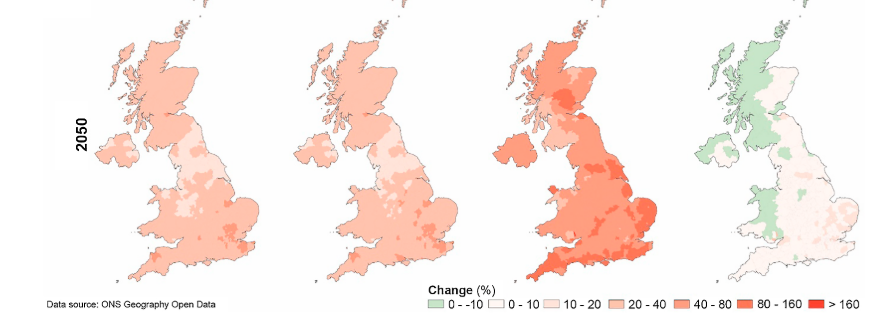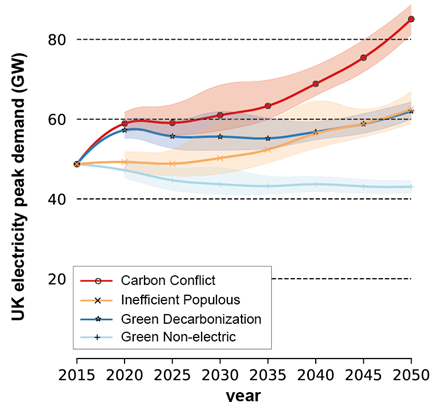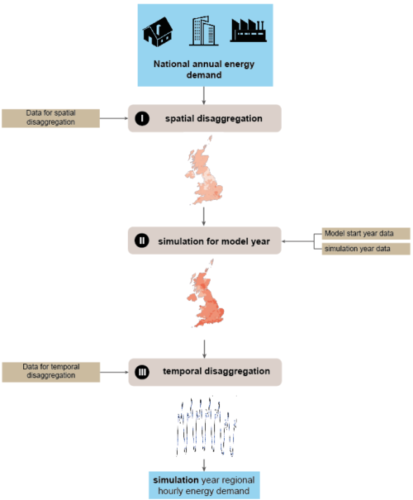THEMES / ENERGY /
ENERGY DEMAND
ENERGY DEMAND
INTRODUCTION
ENERGY DEMAND
RESULTS
The demand for energy will need to undergo significant change in order to achieve emission goals and to transition towards future sustainable energy systems. The future of demand of energy is however highly uncertain. Whereas existing models mainly simulate future energy demands on a national and annual scale, we simulate energy demands on a high spatio-temporal resolution. Because drivers of energy demand such as population are highly spatial in nature, capturing changes in energy demands on a regional scale enables local energy systems planning.

Figure 1: Change in total electricity demand (Source: Eggimann et al. 2019).
Results show considerable change in future energy peak demands depending on drivers of energy demand (Figure 2).
Including weather variability shows that weather has a considerable influence on electricity peak demand.

Figure 2: Change in peak electricity demand considering different degrees of electrification, showing a peak increase of up to twice of current electricity demands. Weather variability is indicated with shaded area (source: Eggimann et al. 2019).
We simulate that total peak electricity demand could be reduced by fully managed heat pumps profiles by 0.2–5.8 GW (0.4–11.1%).

Figure 3: Simulating demand side management for large-scale heat pump diffusion considering a managed load profile (left: electricity, right: gas) (source: Eggimann et al. 2019).
ENERGY DEMAND
APPLICATIONS
Energy demands are decomposed in different end-uses and sectors, based on national energy demand statistics. Demand is projected based on a set of scenario drivers such as population, gross value added or temperatures. A building stock representation is included in the model.
Energy demands are spatially disaggregated to about 400 regions with the help of different disaggregation factors such as floor area. Wherever possible, a bottom-up approach relying on measuring trial data is implemented for hourly energy demand modelling for specific technologies or enduses.
The spatial and temporal disaggregation methodology is validated. The simulated demand projections serve foremostly as a key input for energy supply models in order to optimize future energy systems.
Main assumptions / Key Features
- Innovative spatio-temporal high resolution energy demand simulation (regional and hourly).
- Simulates future residential, service and industrial energy demand for various end uses.
- Model is able to include weather variability.
- Mixture of bottom-up and top down simulating methodology using national energy demand statistics and actual specific load profiles.
- The model allows embedding regional changes in energy demand for different fuel carriers such as electricity, gas or hydrogen.
- The model has and underlying building stock representation, particularly reflecting changes due to different housing and population scenarios.

Figure 4: Modelling methodology overview. i) national energy demands are assigned to regions. (ii) energy demands are projected into the future based on drivers of energy demand. (iii) Annual energy demand is converted to hourly demands.
ENERGY DEMAND
DATA REQUIREMENTS
National energy demand statistics
Daily minimum and maximum temperatures
Hourly load profiles per end-use, technology or sector
ENERGY DEMAND
PUBLICATIONS
A high-resolution spatio-temporal energy demand simulation to explore the potential of heating demand side management with large-scale heat pump diffusion
Localisation of energy technologies and policies is increasing the need for high-resolution spatial and temporal energy demand simulation modelling, which goes beyond annual and national scale. ... read more
ENERGY DEMAND
CASE STUDIES

Low carbon energy supply strategies for the Oxford-Cambridge Arc region
This research was funded by a grant from the UK Engineering and Physical Science Research Council to the ITRCResearch question & scope The energy supply model is utilised to evaluate how ... read more

Cyberattacks on London’s electricity networks costing up to £111m daily
New research shows cyberattacks on London’s electricity networks leads to widespread disruption, costing up to £111m daily. read more